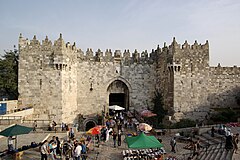Damascus Gate
| Damascus Gate | |
|---|---|
 |
|
|
Location in Old Jerusalem
|
|
| General information | |
| Town or city | Jerusalem |
| Coordinates | 31°46′53.9″N 35°13′49.8″E / 31.781639°N 35.230500°E |
| Completed | 1537 |
Damascus Gate (Arabic: باب العامود, Bab al-‘Amud, Hebrew: שער שכם, Sha'ar Sh'khem) is one of the main entrances to the Old City of Jerusalem. It is located in the wall on the city's northwest side where the highway leads out to Nablus, and from there, in times past, to the capital of Syria, Damascus; as such, its modern English name is Damascus Gate, and its modern Hebrew name, Sha'ar Shkhem (Hebrew: שער שכם), meaning Shechem Gate, or Nablus Gate. Of its Arabic names, Bab al-Nasr (Arabic: باب النصر) means "gate of victory," and Bab al-Amud (Arabic: باب العامود) means "gate of the column." The latter name, in use continuously since at least as early as the 10th century, preserves the memory of a design detail dating to the 2nd century AD Roman era gate.
In its current form, the gate was built in 1537 under the rule of Suleiman the Magnificent, the Sultan of the Ottoman Empire. Beneath the current gate, the remains of an earlier gate can be seen, dating back to at least the time of the Roman Emperor Hadrian in the 2nd century CE. In front of this gate stood a Roman victory column topped with the Emperor Hadrian's image, as depicted on the 6th century Madaba Map. This historical detail is preserved in the current gate's Arabic name, Bab el-Amud, meaning "gate of the column". On the lintel to the 2nd century gate, under which one can pass today, is inscribed the city's name under Roman rule, Aelia Capitolina. Hadrian had significantly expanded the gate which served as the main entrance to the city from at least as early as the 1st century CE during the rule of Agrippa I.Josephus mentions in his Antiquities of the Jews that the third and outer wall of Jerusalem's Old City had been originally built by Agrippa I, in circa 37 CE – 41 CE.
...
Wikipedia

